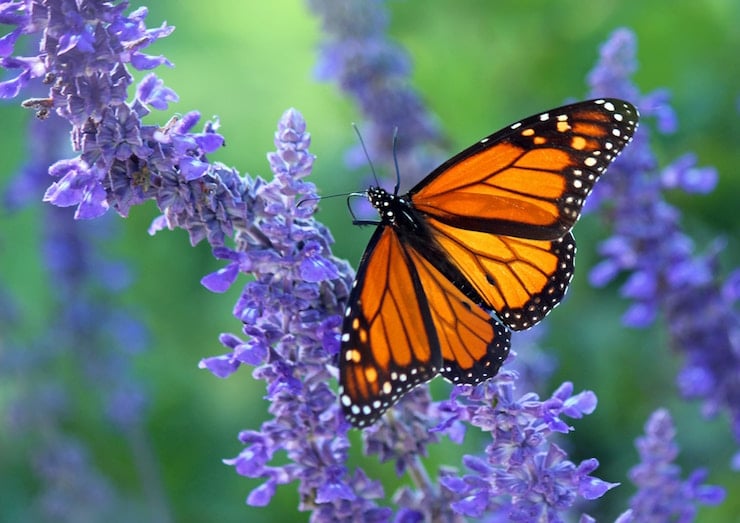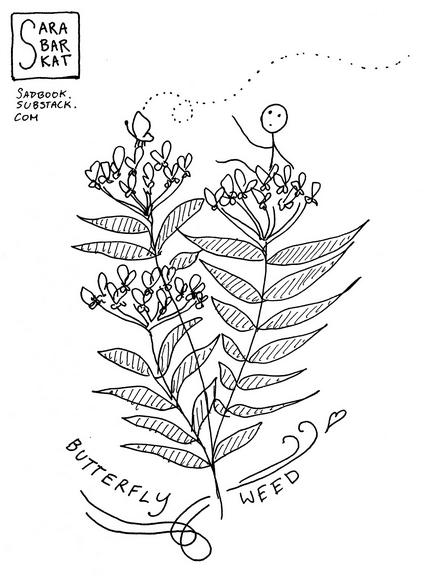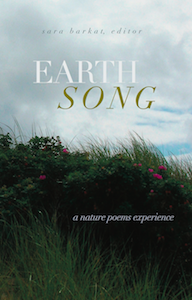The Gift of the Monarch Butterfly
Sue stood at our door, holding an odd-looking plant with a green stem and a dangling pod.
“It’s for Raj,” she said brightly, extending it toward me. I leaned forward tentatively for a closer look, then realized it wasn’t a plant—it was a chrysalis.
At a recent social gathering, Sue, an avid gardener and amateur naturalist, had shared her fascination with the annual monarch migration through Indiana. Every year, she planted milkweed to attract them to her yard and then watched as their eggs grew and developed. My husband Raj listened to her with bated breath.
Raj’s friends sometimes call him “Google” due to his oddly encyclopedic knowledge and interests, ranging from semiconductors to geology, aeronautics to forestry, computer coding to—apparently—insects.
Hence, Sue’s…gift.
Though I wasn’t sure how I felt about an insect pupating inside my home, I took the chrysalis with as much grace as I could muster, refrained from mentioning my entomophobia, and thanked her for this (somewhat unusual brand of) thoughtfulness.
After she left, I put the chrysalis in Raj’s office room and firmly shut the door. Still, the fragile pod remained on my mind over the following week, and I glanced uneasily toward that door whenever I walked past. What’s happening in there? Is it growing? Did it break through? Is it flying around?
Eventually, curiosity drove me to open the door a crack and peek inside the room, and, after ensuring the chrysalis was nowhere close to opening, I consulted Google (no, the actual Google). Apparently, this particular butterfly was one of millions on a 3,000-mile, four-generation-long migratory path from Canada to Mexico. It would hatch, fly part of the route, and lay eggs; then the next generation would continue onward.
The question that puzzled most people, myself included, was this: how exactly did it know when and where to fly?
Scrolling down, I learned that the monarch’s orientation mechanism is a sun compass, based upon a time-compensating circadian clock located in its antenna—with a backup light-dependent inclination magnetic compass for orientation under overcast conditions.
Holy smokes. I looked toward the budding butterfly with more respect.
These days, any responsible discussion of any living thing must include the impact of climate change upon it. With a sinking feeling, I read that the monarch butterfly population has reduced by more than 90% since the 1980s, and continues to decline steeply due to rainfall changes, temperature deviations, pesticide usage, and habitat loss. Another reason is the reduction in available milkweed, the essential food source for monarch larvae. Suddenly, I felt far more grateful for Sue’s milkweed-planting efforts.
In short, the monarch butterfly is at what’s known as an “extinction tipping point.”
I closed all of the browser windows.
Turning Toward
Our planet is in the middle of its sixth mass extinction, defined as the loss of three-fourths of all species in existence. For an attempt at perspective, the fifth mass extinction wiped out the dinosaurs 65 million years ago.
How can a human mind comprehend a problem this enormous, this global in scope? How can it process the death and dissolution of entire species?
Mine can’t.
I find I am turning away from climate news and data more and more quickly, closing my mind, closing my browser windows, even though every fiber of me knows it is wrong to do so.
Part of my difficulty is, of course, the immensity of the problem, but more than that, it’s the baffling contradictions. Yes, global disaster looms, and yet, work and laundry routines continue. Yes, floods and fires are creeping closer to home, and even so, a perfect spring day blooms outside. Yes, scientists have ascertained a small (though shrinking) window for correction, but lawmakers are uninterested or unable to act.
Richard Powers’ novel Bewilderment, aptly titled, relates a father’s journey to help his child contend with all of those contradictions, though he finds them incomprehensible himself. His young son is in love with all of the creatures of the world, desperately trying to sketch them all, to document their existence before they are lost, to shout into the void yes, yes, you matter, you matter to me.
More than news and documentaries, it is this emerging literary genre of “climate fiction” that is helping me understand how to exist with the approaching climate calamities. Given our visiting butterfly, I was particularly pleased to come across Barbara Kingsolver’s novel Flight Behavior.
In Kingsolver’s story, climate change has altered the migratory path of millions of monarchs, diverting the hordes to the edge of a small American town, rather than their expected over-wintering location in Mexico. The uneducated protagonist struggles to understand what has happened, what is at stake, and how to come to terms with watching in real time the extinction of an elegant and intricate species. She then attempts to communicate to her young child what his future will bring.
Engaging with such stories modeled for me how to remain present and process what is occurring around me without turning away. The characters showed me how to behold, how to explain, how to stay standing, and how to keep going. They provided a way to grapple and grieve.
And they reminded me that so many people are grappling and grieving.
Eyes Open
The current geological age is often referred to as the Anthropocene, the prefix anthro denoting how human activity constitutes the primary impact upon the planet and its climate, biodiversity, and ecosystems.
For me, this label highlights the mother of all contradictions. Human intelligence has built sprawling civilizations and complex technologies, but at the expense of the land and environment in which human existence is rooted.
My deepest hope is that that same intelligence will now do what is needed before the clock expires on millions of species, billions of creatures, and indeed, on humanity itself.
In the meantime, I am battling my desire to blame past actors and past actions, because that accomplishes nothing. I am disallowing my despair, because that only waves responsibility off to future generations.
Here, in this middle generation, on the cusp of what’s to come, I know I must witness, speak, and act. As Daniel Sherrell resolved in his poetic and despairing millennial memoir Warmth, which explores whether his generation ought even to have children, “[t]o mourn without fighting is to tap out at the exact moment we need to step in.”
What I owe, for the privilege of my life on this beautiful and still intact planet is my eyes open.
***
As for the little monarch, it remained on my mind during its short stint in my home. Somehow, I began to regard it less as an insect in pupation, and more as a piece of life, singular and precious, in the midst of transformation. Had I seen it outdoors, I’d have dismissed it as a mere bug, but my prolonged attention made me consider its significance in the grand scheme.
I thought I’d be present to witness its emergence, to see it fly instinctively southward, trusting that its compass would guide it correctly, that the next generation would continue the journey, that all would unfurl and unfold as it should. But I wasn’t home when it happened, and Raj released the hatchling into the world.
I returned, and it was gone.
Try It: Action & Writing Prompts
1. Plant Milkweed. Milkweed, a wildflower native of wetlands and prairies, is a food source for monarch butterflies and a host plant for their eggs. It also draws other pollinators, such as bees and hummingbirds. Consider using a section of your own garden to plant milkweed, aster, wild bergamot, and other perennials that provide a habitat for pollinators.
2. Partner in Planting. While I served as an education grant director, our program provided funding to a high school biology classroom to plant a pollinator garden in a local park. Consider partnering with a local school and local community/urban garden space and coordinating a similar project.
3. Write a poem to a creature on the endangered species list. In your poem, address why you chose it and what you—and the world—would miss if it were lost to existence.
4. Write a poem from the perspective of the same creature. What does it wish to express, knowing that its species may not live on?
Photo by Marian Brandt, Creative Commons, via Unsplash. This post is a modified reprint from DheepaMaturi.com.
Earth Song: A Nature Poems Experience
- Morphing: Lessons from the Year of the Monarch - October 23, 2024
- Year of the Monarch: Butterfly Kisses—A Romantic Comedy - August 7, 2024
- Year of the Monarch: In Sync — a Communal Poem for the Monarch Butterfly - April 11, 2024




L.L. Barkat says
I love this, Dheepa.
And, I hear you about the way it can get discouraging on the climate reality. We are not built, as humans, to always be thinking in the grand scale, nor in the abstract. Touching life—close up—that’s where we grasp things best. So I think you are really onto something by looking through the lens of one beautiful creature (the Monarch) 🙂 I was stunned by that stat about the 90% population loss. This week I’ll be purchasing some Butterfly Weed to do my small part:
https://www.birdsandblooms.com/gardening/attracting-butterflies/butterfly-weed/
Dheepa R. Maturi says
Yes, I think our “small parts” add up, and quickly! I am making space for a pollinator garden as well!
L.L. Barkat says
I think it would be interesting to know how many pollinator gardens would be needed to help bring the Monarch back to life. Also, what else we might do. I do look forward to having more conversations about this with you and others, Dheepa! 🙂
Laurie Klein says
Oh, Dheepa, thank you for this timely, stirring essay: responsible and responsive, intelligent, spiritual, sobering. I started researching monarchs some years ago, was shocked by statistics, planted buddleia and bergamot, then flitted off toward other curiosities. I NEEDED my attention re-stirred. My buddleia and bergamot both perished one winter, and I never replaced them. I should remedy that.
Many a childhood summer I zig-zagged through heartland fields studded with milkweed, waving my DIY butterfly net. I must research a milkweed variety suited to the inland northwest . . .
Laurie Klein says
Just to add, it was catch-and-release only. And perhaps the first time as a young person I glimpsed my power.
Dheepa R. Maturi says
Yes, I figured as much! Ooooh, that sounds like a poem in the making–a child discovering her power in the butterfly fields!
Laurie Klein says
Dheepa, thank you for that inspired suggestion! I will see what comes . . .
Dheepa R. Maturi says
Laurie, thank you so much for your note! I love your childhood memory of the butterfly fields, especially given how much of their habitat has been lost in recent years. And I especially love that your first response to your monarch research was to plant buddleia and bergamot! I, too, am learning more and planning on planting–if I find a list of ideal milkweed varietals by geographic location, I will send it your way. Grateful for you, Laurie!
Laurie Klein says
Thank you!
Dheepa R. Maturi says
I came across this resource list for butterfly garden planting in the Western U.S.: https://www.laspilitas.com/butterfl.htm. Hope it’s helpful!
Dheepa R. Maturi says
Also this: https://monarchbutterflygarden.net/western-monarch-butterfly-resources/
Laurie Klein says
Dheepa, thank you so much for these two resources!
Angela Bordio says
Hi, Dheepa! I just came across this beautiful essay, and I must say I was captivated by the your storytelling. The way you describe receiving a chrysalis as a gift and their journey of understanding the significance of the monarch butterfly’s migration and the impact of climate change is truly moving. I am grateful to have come across this thought-provoking piece!
Dheepa R. Maturi says
Angela, I’m so delighted that the essay resonated with you! And I truly appreciate your taking the time to read and comment–thank you!